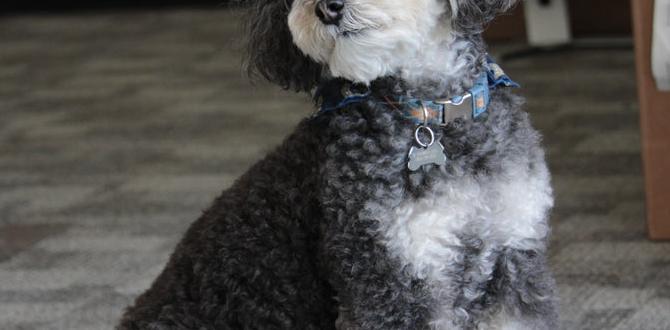Have you ever noticed your dog trembling during thunderstorms? It’s tough to see your furry friend so afraid. Learning how to calm an anxious dog is important for their well-being. Every dog reacts differently to stress. Some hide, while others bark or pace. Each response shows their anxiety.
Did you know that nearly 1 in 3 dogs show signs of anxiety? That’s quite a lot! Knowing how to soothe them can help both you and your pet feel better. Imagine cuddling on the couch, enjoying a peaceful evening, instead of worrying about your dog’s panic. With some simple techniques, you can turn anxiety into calm.
In this article, we’ll reveal effective ways to help your dog relax. You’ll discover fun tips that make the journey enjoyable for both of you. It’s time to transform those anxious moments into happy memories!
How To Calm An Anxious Dog: Tips And Techniques For Relief

How to Calm an Anxious Dog
Many dogs face anxiety, which can show up as barking, pacing, or hiding. Understanding why your dog feels anxious is important. Some common causes include loud noises, new environments, or separation from their owners. You can use simple methods to help. Gentle music, safe spaces, and calming scents can work wonders. Providing regular exercise and mental stimulation also helps your furry friend feel more relaxed. Isn’t it amazing how a little kindness makes such a big difference?Understanding Dog Anxiety
Common causes of anxiety in dogs.. Signs and symptoms to identify an anxious dog..Many dogs get anxious, much like a kid on the first day of school! Common causes of their anxiety include loud noises, changes in routine, and being left alone. Dogs can also feel stressed during car rides or when meeting new people. Spotting an anxious pup is key. Look for signs like whining, pacing, or hiding. These clues help you understand your furry friend’s feelings sooner than you can say “treat!”
| Common Causes | Signs of Anxiety |
|---|---|
| Loud noises | Whining |
| Change in routine | Pacing |
| Being home alone | Hiding |
Creating a Calm Environment
Tips on arranging your home to reduce anxiety triggers.. The importance of a safe space for your dog..Making your home a calm place can help a nervous dog feel safe. Start by removing loud things that may scare your pet, like the vacuum or noisy toys. You want a quiet spot for your dog where they can relax. This space should include their favorite blanket or bed. Here are some tips:
- Choose a room away from busy noises.
- Add soft lighting for a peaceful feel.
- Keep their favorite toys close by.
- Use calming scents like lavender.
By creating a cozy area, you help your furry friend feel more secure.
Why is a safe space important for my dog?
A safe space helps your dog relax. It gives them a place to escape from fear. When dogs feel safe, their anxiety decreases, making them happier and healthier.
Training Techniques for Calming
Effective training methods to ease anxiety.. The role of positive reinforcement in behavior modification..Training can help dogs feel less anxious. Using simple methods is effective. Start with positive reinforcement. This means rewarding your dog for good behavior. You can use treats, praise, or toys. This helps your dog learn what to do. Also, try gradually exposing your dog to their fears. This method is called desensitization. With time, your dog learns to cope better. Stay patient and consistent. You will see progress!
What are some effective training methods for easing anxiety in dogs?
Some effective training methods include positive reinforcement, desensitization, and regular exercise.Here are a few key techniques:
- Use treats to reward calm behavior.
- Start short training sessions.
- Introduce new experiences slowly.
- Keep routines consistent.
Behavior Modification Strategies
Techniques to change anxious behavior over time.. The significance of consistency and patience in training..Changing your dog’s anxious behavior takes time and patience. Start with small steps. Reward calm moments with treats or pets—this builds trust. Consistency is key; try to keep routines regular. Just like humans, dogs benefit from knowing what to expect. Here’s a simple table to help you track progress:
| Technique | Description |
|---|---|
| Desensitization | Gradually expose your dog to fear triggers. |
| Positive Reinforcement | Give treats for calm behavior. |
| Calm Environment | Create a safe space with toys and soft beds. |
Even little victories count! Celebrate each step, and remember, good things come to those who wait (especially in paw-sitive reinforcement)! Dogs, like us, need love and patience to feel secure.
When to Seek Professional Help
Indicators that professional intervention may be necessary.. Types of professionals that can assist with dog anxiety..Sometimes, anxious dogs need special help. Look for signs like constant barking, hiding, or not eating. If these happen often, it could be time to seek help. Professional trainers and veterinarians can guide you. They understand dog behavior well and can provide effective solutions. Here are some professionals to consider:
- Veterinarians: They help with health issues related to anxiety.
- Dog trainers: They teach skills to manage anxiety.
- Behaviorists: They specialize in dog behavior problems.
When should I consider getting help for my dog?
If your dog struggles with anxiety daily, consider professional help. Emergency situations require immediate action for your pet’s safety and comfort.
Case Studies and Success Stories
Sharing reallife examples of calming anxious dogs.. Lessons learned from different cases and their outcomes..Many dog owners have seen their pets calm down after trying different methods. Here are some inspiring stories:
- A shelter dog named Max had severe anxiety. His new owner used a routine with gentle hugs. Now, Max enjoys walks and playing fetch.
- An Aussie named Bella was scared of loud noises. Her owner created a safe space with calming music. Bella now relaxes during storms.
- Chloe, a rescue pup, worried about new places. Her owner took baby steps to explore outside and praised her. Chloe now loves adventures.
These cases show that patience, love, and small steps can lead to success. Remember, each dog is unique and may respond to different calming strategies.
What are some methods to calm a dog?
Many methods can help calm an anxious dog. Try using calming music, providing a cozy space, or using toys for distraction. Simple routines can also make a difference.
Maintaining Long-Term Calmness
Tips for ongoing management of canine anxiety.. The importance of routine and stability in a dog’s life..Creating a calm environment for your furry friend is important. A regular schedule helps dogs feel safe and secure. Think of it like their very own doggy calendar! Keep feeding, walks, and playtime at the same times daily. This way, they can rely on predictable routines. Use calming tools like soft music or cozy blankets. Just like humans, some dogs might need a nap after a big day of barking. Always remember: happy dogs equal happy owners!
| Tip | Description |
|---|---|
| Routine | Daily schedules help reduce anxiety. |
| Comfort Items | A favorite toy can be a big help! |
| Calm Spaces | Create quiet areas for relaxation. |
Conclusion
To calm an anxious dog, you can create a safe space, use soothing techniques, and stick to routines. Regular exercise helps too! You can try training games to distract them. If worries continue, don’t hesitate to talk to a vet. Together, we can help our furry friends feel more relaxed and happy. Keep learning and enjoy your time with your dog!FAQs
What Are Some Effective Techniques To Soothe An Anxious Dog During A Thunderstorm Or Fireworks?To help your anxious dog during a thunderstorm or fireworks, you can create a safe space for them. This could be a cozy corner with their favorite blanket and toys. You can also play soft music to drown out loud noises. Staying calm and giving them gentle pets can help. Lastly, using treats or toys can keep them distracted and happy.
How Can I Create A Calming Environment For My Dog At Home?To create a calming environment for your dog, start by finding a quiet space for them. You can use soft blankets or a cozy bed for comfort. Keep the room free from loud noises and distractions. Play soft music to help them relax. Lastly, spend time with your dog by petting and talking to them gently.
Are There Specific Calming Products Or Supplements That Can Help Reduce My Dog’S Anxiety?Yes, there are calming products and supplements that can help your dog feel less anxious. Things like calming chews, special treats, and sprays with natural ingredients can be useful. You can also try a comfy blanket or a safe space where your dog can relax. Always ask your vet before giving your dog any new supplement to make sure it’s safe.
How Can I Train My Dog To Cope With Social Anxiety Around Other Dogs And People?To help your dog with social anxiety, start by introducing them to calm dogs and friendly people. You can take short walks where you see others but keep a distance at first. Give your dog treats when they stay calm. Over time, slowly bring them closer to the dogs and people. Always praise and reward good behavior to help them feel safe.
What Role Does Exercise Play In Reducing Anxiety Levels In Dogs?Exercise helps dogs calm down and feel happy. When dogs run and play, their bodies release special chemicals that make them feel better. Moving around also gives them a chance to explore and use their energy. This can help keep their minds sharp and reduce worry. So, taking your dog for walks or playing fetch can help them feel less anxious!
Meet Elyse Colburn, the devoted canine companion and storyteller behind the enchanting world of “Tales, Tails, and Adventures Unleashed.” A passionate dog enthusiast with a heart full of paw prints, Elyse Colburn shares heartwarming tales and insightful adventures, celebrating the joy, loyalty, and endless antics that make every dog a true hero. Join Elyse Colburn on this tail-wagging journey, where every post is a love letter to our four-legged friends.






